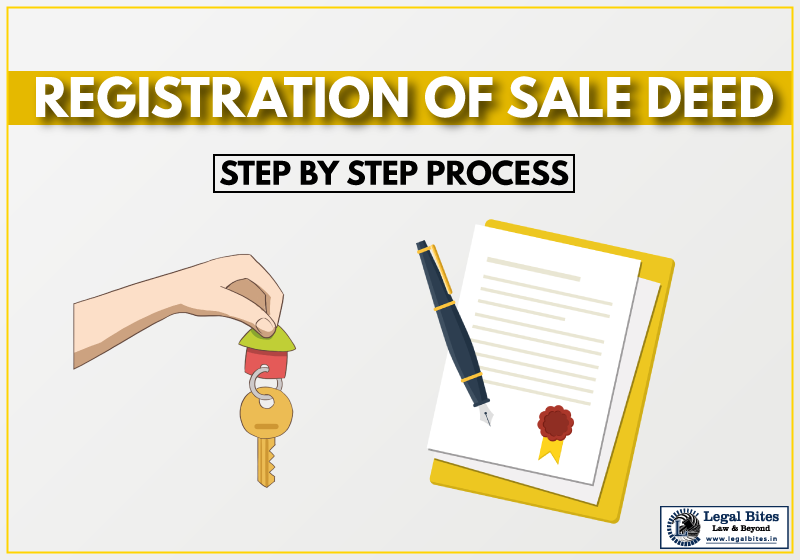Registration of Sale Deed - Step By Step Process and Draft Deed
The sale deed is a legal document that proves that the sale is complete. It contains details of the buyer, seller, area, location of the property, and payment details. The sale deed has to be registered by the near sub-registrar but before registration make sure that full consideration is paid. Only registered sale deed has legal value in… Read More »

The sale deed is a legal document that proves that the sale is complete. It contains details of the buyer, seller, area, location of the property, and payment details. The sale deed has to be registered by the near sub-registrar but before registration make sure that full consideration is paid. Only registered sale deed has legal value in the eye of law. It also bound the buyer and seller to fulfil their agreed terms and conditions.
Section 54 of the Transfer of Property Act 1885 defines sales that means the transfer of property or transfer of ownership from the seller to the buyer for the consideration of money for paid, partly paid, or promised to pay.
Process of registration of sale deed
Step 1: Preparation
- You must pay the total consideration amount as per the agreement to a sale before registration of the sale deed.
- Next thing you should remember that there should not be any arrears due on a property. Such as previous loans, house tax, society dues, etc. If there are such dues left then the registrar can refuse to register sale deed.
Step 2: Calculation of Stamp Duty
- Stamp duty is imposed on the circle rate or actual value whichever is higher. Stamp duty can be between 3-10% [depends upon on state]. In Delhi, stamp duty is 6% for male, 4% for female, and 5% for joint ownership (where the property is a purchase in the name of wife and husband).
- Along with stamp duty, you need to pay 1% for the registration charges.
Step 3: Payment of Stamp Duty
Method 1: E-Stamping
- Visit Stock Holding Corporation of India site https://www.shcilestamp.com/ and click online payment option. Online Payment facility is available for Delhi, Gujarat, Chhattisgarh, Karnataka, Himachal Pradesh, Odisha, Tripura, Ladakh, Chandigarh, and Jammu & Kashmir for now. Get yourself registered by entering the necessary details and pay the stamp duty through Net Banking/Debit Card/NEFT/RTGS/FT.
- After submission of stamp duty, you are required to carry a print out of the Online Reference Acknowledgement No. & are requested to visit the nearest Stock Holding Branch to take a final print out of the e-Stamp Certificate. Every stamp paper has a unique identification number that can be used for future reference.
- You can also visit the nearest SHCIL/Bank Authorized Collection Center, pay stamp duty there, and provide your necessary details. SHCIL/Bank Authorized Collection Center will issue stamp paper.
- A list of SHCIL/Bank Authorized Collection Center is available on https://www.shcilestamp.com/. Choose state then click SHCIL/Bank Authorized Collection Center and get a pdf in which list of approved Banks is given. For Delhi visit https://www.shcilestamp.com/ACC_delhi.pdf
Method 2: Non-Judicial Stamp Paper
- Purchase stamp paper for the required amount from the Authorized Stamp Vendor in your area. Visit https://www.shcilestamp.com/ to get a list of Authorized Stamp Vendors.
- Print the sale deed on the stamp paper but if the sale deed has more pages than the stamp paper then you can print the rest deed on the plain pages and attach it with the stamped deed.
Step 4: Draft and Print Deed
- Draft sale deed by mentioning buyer, seller and payment details, a sale of terms etc. The sale deed should not be conditional.
- If you have an e-stamp then print the deed on plain paper and attach it with e-stamp.
Step 5: Registration @ Sub Registrar Office
- Take an appointment for the nearest sub-registrar, they will give you a token number in which date and time mention for the appearance in front of the sub-registrar.
- You can take an appointment online also only for those states which provide an e-stamping facility. For Delhi visit, https://srams.delhi.gov.in/ select your area then click on the yes button if your documents are complete. Enter the e-stamp number and verify your e-stamp number. After verification, you will receive a message in which details of the appointment are provided.
- On the appointment date, the buyer and seller must be present at the time of registration along with two witnesses each.
- The buyer and seller have to sign each page and witnesses have to sign only a last page. Buyer and seller fingerprints will also be taken at the time of registration.
Step 6: Collection of Registered Sale Deed
- Collect token slip after signing the sale deed in the sub-registrar office. Token slip is used for future references and while collecting the original registered sale deed.
- Original registered sale deed can be collected in 15-20 days after registration. In case of a loan, the bank will directly collect original registered deed from the sub-registrar office.
Documents Required
- Duplicate copy of the Sale Deed that needs to be registered
- Two passport size photographs of the buyer and seller
- ID proof such as Aadhaar card, Voter’s ID card of all the parties
- Certified true copies of Certificate of Incorporation in case of a company.
- Copy of the property register card to indicate that the property does not belong to any Government authority.
- To indicate the year of construction of the property, copy of the municipal tax bill
- PAN Card of both seller and the buyer
- Stamp paper or e-stamp and registration fees receipt.

